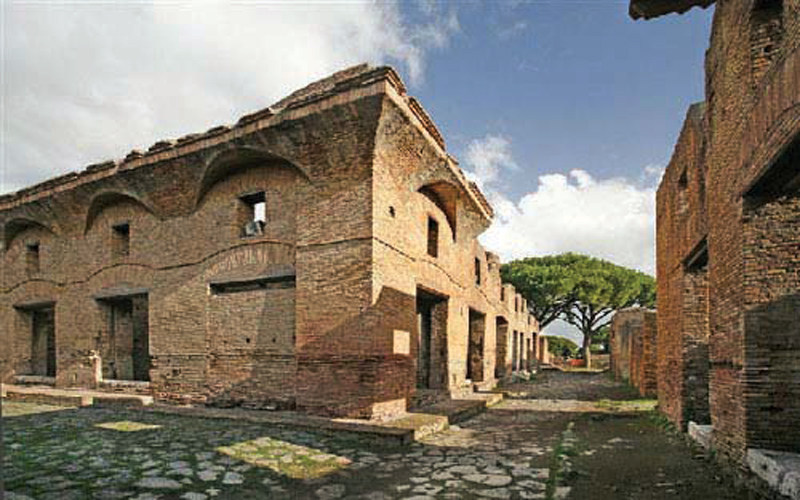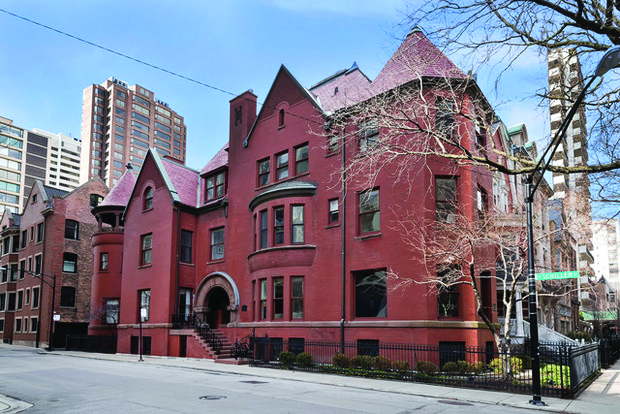Please, Muddy the Waters: Silted Cities
My last travel column was “Dream Castles” - three castles that claim to be the inspiration for Disney’s Sleeping’s Beauty Castle -

the place where the heroine slept for 100 years, awakening not looking a day older. (And she was awakened by her prince – not her plastic surgeon.) Let’s journey from “Dream Castles” to “Dream Towns” – from Princesses – who have awakened intact after sleeping for 100 years – to towns that are intact after sleeping for hundreds of years and even millennia. These towns frozen in time are not fairytales – but exist all over the world.
In my “Great Planned Cities” 92nd Street Y lecture series, I show how the violent impact of nature reshaped cities – such as the volcanic eruptions of Pompeii and Herculaneum (79 AD), the Great Fire of London (1666) and the Lisbon Earthquake (1755). What do those cities have in common? Their natural disasters destroyed property and lives.
Silted cities maintain property, save lives and – and the best part — preserve ancient cities to be rediscovered and visited. What do all those cities have in common with the real estate TV shows on Bravo and HGTV? “Location, Location, Location.” They were all thriving port cities with harbors that silted up rendering them useless and forgotten by time. Silted cities were abandoned because they no longer served their purpose — ports for shipping — just as in the American Old West mining towns were abandoned when the mines ran out of gold.
Here’s the dirt on my favorite silted cities: Ostia Antica (Italy), Aigues-Mortes (France) and Bruges (Belgium).
The Ancient Roman buried and forgotten city of Ostia Antica is only a short Metro ride from the center of Rome. (It’s easy to confuse “Ostia Antica” with the nearby modern resort beach town of Ostia — “Ostia Lido.”) Ostia Antica reflects my favored sediment sentiment – silting for preservation. Before silting Ostia Antica was the port of Rome where the Tiber River met the Mediterranean Sea. Ancient Rome was dependent on Ostia Antica for necessities from food to wild beasts (for contests in the Coliseum). And occasionally for wild beasts as food in the more daring Ancient Roman restaurants.
The Tiber’s navigable loss is Ostia Antica’s sightseeing gain.
Pompeii and Herculaneum were buried by different types of volcanic ash – both very difficult and time consuming to extricate – not so with Ostia Antica’s silted composite. As with Pompeii and Herculaneum, Ostia Antica has ubiquitous Ancient Roman public baths, temples and amphitheater. Pompeii has no buildings with second stories. Herculaneum has many buildings with second stories. To top them all (literally), Ostia Antica has multistoried apartment blocks. — forerunner of the modern apartment house.
However, unlike the primarily residential Pompeii and Herculaneum, Ostia Antica was a working city – an active port with warehouses. (Pompeii was also “working city.” However, ladies of the night (and day) — who conducted business in Pompeii’s preserved house of prostitution — don’t count.)
There are many similarities to Pompeii and Herculaneum. Yes, Ostia Antica has the same Roman flagstone paved roads in which you can get into a rut – formed by the wheels of chariots. And there are Ostia’s shops – from laundries to bakeries to wine shops. Ostia’s wine shop also served food. How do we know? A fresco — showing of a plate of food served — still exists on its wall. It’s the Ancient Roman equivalent of an Ancient American institution – Woolworths that displayed photographs of food they served.
And if it’s entertainment you’re after – ancient or modern — Ostia Antica’s amphitheater is much more impressive than Pompeii’s – since Ostia’s is in a much better state of preservation.
Like Pompeii, Ostia Antica also has homes of the wealthy. (The rich owners of all those warehouses had to live somewhere.)
While Ostica Antica has many of the same building types as Pompeii and Herculaneum, Ostia has even more fascinating building types you won’t find in those two more popular cities. While every Ancient Roman city from England to Africa to the Middle East had a forum, Ostia Antica had the usual forum – and another. Because there are so many warehouses – Ostia has a “Forum of Warehouses.” In fact, just about every warehouse identifies its function by its floor mosaic subject. My favorite warehouse mosaic is “The Grain Shippers.” (And if you want to take that with a “grain of salt” –- Ostia even had a salt warehouse.)
Because many warehouses stored very valuable commodities (and many were flammable), Ostia Antica even has the remains of an ancient firehouse.
The graffiti of Pompeii and Herculaneum is fascinating — Ostia Antica’s graffiti is even more so. Instead of merely Latin graffiti, the international port of Ostia Antica has graffiti in other languages, too.
Because Ostia Antica was an international business city – there are religious institutions not found elsewhere. The Villa of the Mysteries in Pompeii depicts an unknown cult. Ostia Antica has an actual temple of a mysterious cult – The Temple of Mithras. Ostia’s most surprising religious building is Ostia Antica’s ancient Roman synagogue.
There’s a great attraction for people of all religions. Not far from the “Deecumanus Maximus” (Ostia Antica’s main street) is a site for the Ancient Roman’s “Gluteus Maximus.” Ostia Antica has a unique site that has yet to be discovered at either Pompeii or Herculaneum – public latrines – very apropos for a silted city – backed up toilets.
Traveling forward in time from Ancient Rome to the Middle Ages – and from Italy to Southern France – is the perfectly-preserved medieval walled- city of Aigues-Mortes — just 20 miles from Nimes. Aigues-Mortes should be on everyone’s sightseeing must-see list for Provence and the nearby Cote d’Azur. It has something in common with Ostia Antica – the enclosed walled-in town is also based on a simple grid – a rectangular grid – easy to negotiate once you’re inside the gates.
While you can walk the ramparts of France’s most famous medieval walled city – Carcassonne — unlike Carcassonne you can walk original medieval ramparts in Aigues-Mortes. Carcassonne is one of the best examples of 19th-century over restoration – so bad it was almost a recreation from the imagination of Viollet-le-Duc — the restorer of Paris’ Notre Dame Cathedral. Or what I like to call, “FAKE Restoration!” Carcassonne is to medieval walled cities what Disneyland’s Sleeping Beauty Castle is to castles.
Walking Aigues Mortes’ perfectly-preserved ramparts ranks up there as a memorable travel experience along with walking the ramparts of Spain’s medieval walled city, Avila — the ramparts of England’s walled cities of Chester and York – and the ramparts of Dubrovnik’s walls (Croatia).
Besides being one of Europe’s best-preserved medieval walled cities – Aigues-Mortes has an illustrious history to match. French King Louis IX built Aigues-Mortes in the 13th century to serve as port – not just for trade – but as the embarkation point for the Crusades. And since the world’s greatest crusader fort, Krak des Chevaliers, is now off limits in Syria – easily reachable Aigues-Mortes has assumed even greater sightseeing importance.
As with the history of the famous Tower of London – Aigues Mortes has many towers worth visiting such as its medieval Constance Tower –which like the Tower of London – was also used as a prison – but for a different clientele — Huguenots (French Protestants).
During the 19th century, Aigues-Mortes was visited by many Victorians as part of the Grand Tour. And if New Yorkers want to see how little it’s changed since then – visit the Metropolitan Museum of Art to see the great impressionist Frederic Bazille’s painting of “The Queen’s Gate” –Aigues-Mortes’ main gate.
The meaning of the name “Aigues-Mortes” — “Dead Waters” — also helps to describe why the city was abandoned. The real cause was silted swamps. Sadly, “Drain the Swamp!” was not technologically possible until the 20th century. Aigues-Mortes was neglected during the French Revolution when its surrounding area was deforested – which precipitated major soil erosion – an early ecological disaster.
Another case of silting being a port’s loss but sightseeing’s gain is Bruges, Belgium – probably the world’s most popular silted city – a city of canals (fortunately not silted). Unlike Ostia Antica and Aigues-Mortes — during high season Bruges is dramatically overcrowded. It’s as overcrowded as its travel description is overused – the hackneyed “Venice of the North” – which is why I call Venice, “The Bruges of the South.”
To me Bruges is the “Gothic Colonial Williamsburg” except unlike Williamsburg, Virginia — most of Bruges’ buildings are original – and truly spectacular — including one of the tallest buildings of Medieval Europe – the Bruges Belfry. (From the top of the belfry you can even see the silt.) Ever the medieval city, Bruges has a shrine built around a medieval holy relic – the Basilica of the Holy Blood – which even incorporates two medieval styles — Romanesque basement and Gothic upper.
What’s so great about visiting Bruges, Aigues Mortes and Ostia Antica is they’re all easily accessible via public transportation – trains. In addition Aigues Mortes is near Marseilles International Airport – and Ostica Antica is practically next to Rome’s Leonardo da Vinci Airport. You’ll enjoy your visit to all of those great silted cities – as long as you don’t take a boat.





